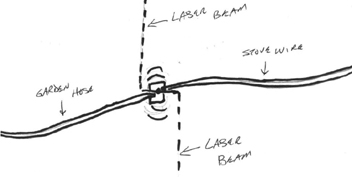
There are many things that can ruin a Saturday. The main one, of course, is realizing that it’s actually Wednesday. But aside from that, the biggest disappointment is knowing you have to cut the lawn. This is something that may be pointed out to you by your significant other, or that becomes clear to you when you can no longer see out any of the windows. Oh sure, I know you have a gas mower that’s pretty easy to use once you get it started and the pain in your shoulder subsides to the point that you can move your arm again, and you’ve accepted the practice of tilting it up every few feet to let the clogged grass spew out into your above-ground pool, and you’re even okay with the odd rock the mower picks up and fires into your neighbour’s trampoline and then who knows where. But I’m thinking there must be a better way. And there is.

Step One: Pick up a couple of laser-beam generators. You can get them cheap from any of those do-it-yourself eye-surgery websites. Laser generators generally run on 110-volt current, but for our application you’ll need more power, so you should hook them up to your stove outlet.
Step Two: Once you’ve got those wired up, attach the lasers to the bottom edges of an old-fashioned rotary lawn sprinkler. You’ll need enough electrical cable and hose to be able to put the sprinkler dead centre in your lawn. Even if it’s not exactly dead centre, it soon will be.

Step Three: Turn on the water, which will get the sprinkler rotating.
Step Four: Put on a full-body rubber wet suit and rubber gloves and stand on a thick rubber mat while you turn on the power switch.
And it’s just that simple. In less than ten rotations, your lawn will be cut perfectly flat and the clippings will be incinerated.
Finally, turn off the power, then the water, and stay off the lawn until it’s completely dry to avoid any residual electrical energy that could impede your ability to grow hair.
CAUTION: Do not use near flower gardens or house pets.
Grain farmers should ask about the military-grade laser beam, capable of harvesting a hundred acres per hour.